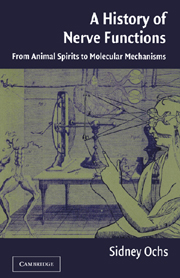Book contents
- Frontmatter
- Contents
- Preface
- 1 Introduction: Greek Science and the Recognition of Nerve as a Channel
- 2 Galen's Physiology of the Nervous System
- 3 Nerve, Brain, and Soul in the Middle Ages
- 4 Renaissance and the New Physiology
- 5 New Physical and Chemical Models of Nerve in the Enlightenment
- 6 New Systematizations of Nerve Function in the Enlightenment
- 7 Electricity as the Agent of Nerve Action
- 8 Nerve Fiber Form and Transformation
- 9 Wallerian Degeneration: Early and Late Phases
- 10 Nerve Regeneration
- 11 Characterization of Axoplasmic Transport
- 12 Molecular Models of Transport
- 13 Actions of Neurotoxins and Neuropathic Changes Related to Transport
- 14 Purposeful Reflexes and Instinctive Behavior
- 15 Neural Events Related to Learning and Memory
- 16 Epilogue: With Observations on the Relation of the Nervous System to Mind
- Bibliography
- Index
13 - Actions of Neurotoxins and Neuropathic Changes Related to Transport
Published online by Cambridge University Press: 13 August 2009
- Frontmatter
- Contents
- Preface
- 1 Introduction: Greek Science and the Recognition of Nerve as a Channel
- 2 Galen's Physiology of the Nervous System
- 3 Nerve, Brain, and Soul in the Middle Ages
- 4 Renaissance and the New Physiology
- 5 New Physical and Chemical Models of Nerve in the Enlightenment
- 6 New Systematizations of Nerve Function in the Enlightenment
- 7 Electricity as the Agent of Nerve Action
- 8 Nerve Fiber Form and Transformation
- 9 Wallerian Degeneration: Early and Late Phases
- 10 Nerve Regeneration
- 11 Characterization of Axoplasmic Transport
- 12 Molecular Models of Transport
- 13 Actions of Neurotoxins and Neuropathic Changes Related to Transport
- 14 Purposeful Reflexes and Instinctive Behavior
- 15 Neural Events Related to Learning and Memory
- 16 Epilogue: With Observations on the Relation of the Nervous System to Mind
- Bibliography
- Index
Summary
A number of agents used in the analysis of axoplasmic transport were noted in the preceding chapters. In this chapter, they are set out in systematic fashion on the basis of what is known of its mechanism. In addition, some neuropathies that appear to be accounted for on the basis of an altered transport will be noted. More extensive accounts of the agents used and neuropathies referred to may be found in general works on these subjects and special volumes.
BLOCK OF SYNTHESIS IN CELL BODIES CAUSING FAILURE OF TRANSPORT
The paradigm of an interference of transport leading to pathological changes in the fiber is the Wallerian degeneration seen in the distal amputated nerve after transection (Chapter 9). It results from the loss of substances needed by the fiber that are continually being supplied to it by axonal transport. An interference with synthesis by the cell bodies similarly results in Wallerian degeneration. This is seen when protein synthesis is blocked by puromycin or cycloheximide. When either of these agents were injected into the dorsal root ganglia shortly before that of a labeled amino acid precursor, or even at the same time, the outflow of labeled proteins was almost completely blocked (Figure 13.1). Puromycin acts by blocking the translation of messenger RNA (mRNA) to protein. It does so because of the similarity of its molecular structure to transfer RNA.
- Type
- Chapter
- Information
- A History of Nerve FunctionsFrom Animal Spirits to Molecular Mechanisms, pp. 284 - 304Publisher: Cambridge University PressPrint publication year: 2004



